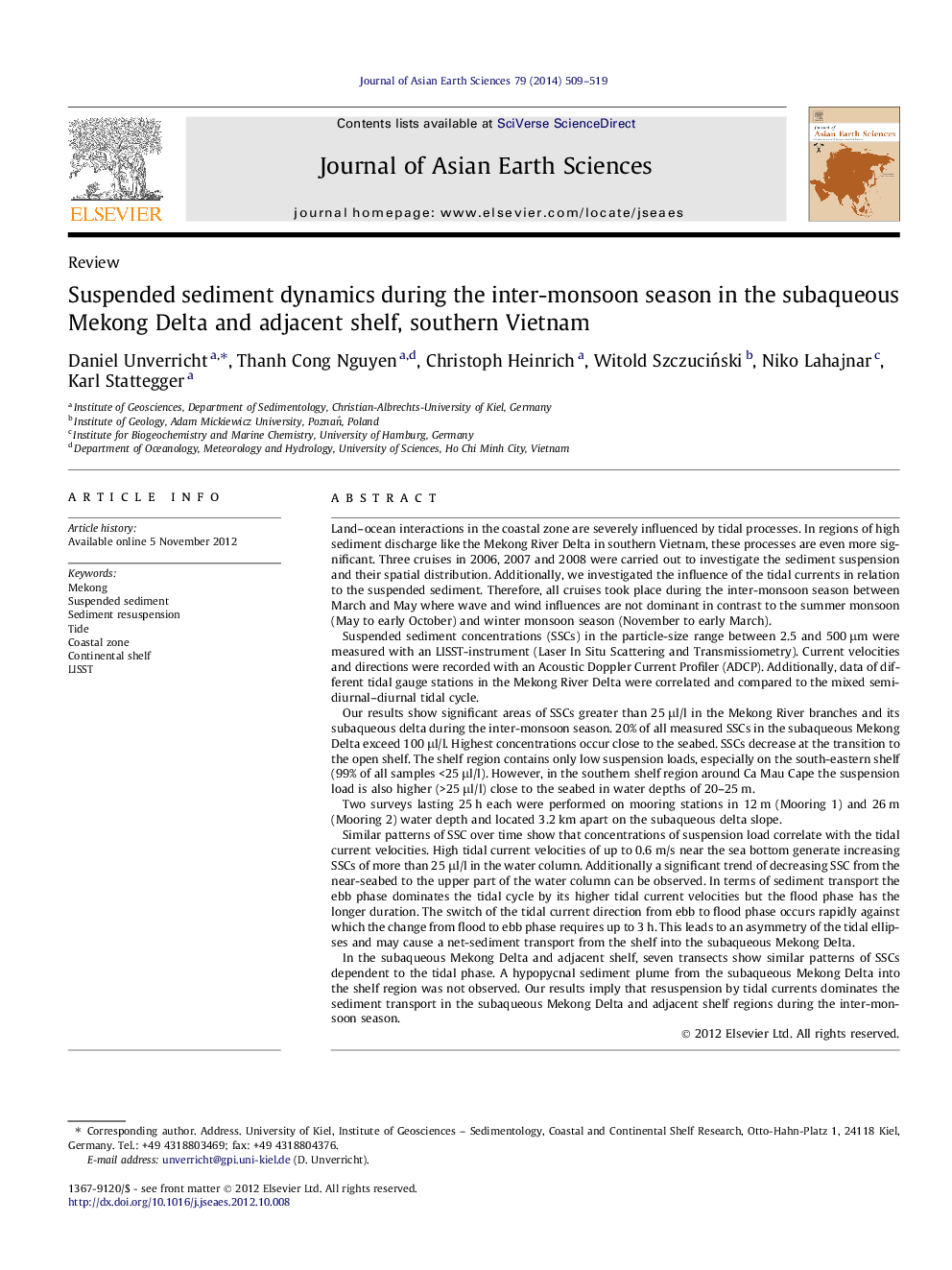| کد مقاله | کد نشریه | سال انتشار | مقاله انگلیسی | نسخه تمام متن |
|---|---|---|---|---|
| 4730927 | 1356785 | 2014 | 11 صفحه PDF | دانلود رایگان |

Land–ocean interactions in the coastal zone are severely influenced by tidal processes. In regions of high sediment discharge like the Mekong River Delta in southern Vietnam, these processes are even more significant. Three cruises in 2006, 2007 and 2008 were carried out to investigate the sediment suspension and their spatial distribution. Additionally, we investigated the influence of the tidal currents in relation to the suspended sediment. Therefore, all cruises took place during the inter-monsoon season between March and May where wave and wind influences are not dominant in contrast to the summer monsoon (May to early October) and winter monsoon season (November to early March).Suspended sediment concentrations (SSCs) in the particle-size range between 2.5 and 500 μm were measured with an LISST-instrument (Laser In Situ Scattering and Transmissiometry). Current velocities and directions were recorded with an Acoustic Doppler Current Profiler (ADCP). Additionally, data of different tidal gauge stations in the Mekong River Delta were correlated and compared to the mixed semidiurnal–diurnal tidal cycle.Our results show significant areas of SSCs greater than 25 μl/l in the Mekong River branches and its subaqueous delta during the inter-monsoon season. 20% of all measured SSCs in the subaqueous Mekong Delta exceed 100 μl/l. Highest concentrations occur close to the seabed. SSCs decrease at the transition to the open shelf. The shelf region contains only low suspension loads, especially on the south-eastern shelf (99% of all samples <25 μl/l). However, in the southern shelf region around Ca Mau Cape the suspension load is also higher (>25 μl/l) close to the seabed in water depths of 20–25 m.Two surveys lasting 25 h each were performed on mooring stations in 12 m (Mooring 1) and 26 m (Mooring 2) water depth and located 3.2 km apart on the subaqueous delta slope.Similar patterns of SSC over time show that concentrations of suspension load correlate with the tidal current velocities. High tidal current velocities of up to 0.6 m/s near the sea bottom generate increasing SSCs of more than 25 μl/l in the water column. Additionally a significant trend of decreasing SSC from the near-seabed to the upper part of the water column can be observed. In terms of sediment transport the ebb phase dominates the tidal cycle by its higher tidal current velocities but the flood phase has the longer duration. The switch of the tidal current direction from ebb to flood phase occurs rapidly against which the change from flood to ebb phase requires up to 3 h. This leads to an asymmetry of the tidal ellipses and may cause a net-sediment transport from the shelf into the subaqueous Mekong Delta.In the subaqueous Mekong Delta and adjacent shelf, seven transects show similar patterns of SSCs dependent to the tidal phase. A hypopycnal sediment plume from the subaqueous Mekong Delta into the shelf region was not observed. Our results imply that resuspension by tidal currents dominates the sediment transport in the subaqueous Mekong Delta and adjacent shelf regions during the inter-monsoon season.
► First data of suspended sediment off the subaqueous Mekong Delta and adjacent shelf.
► During the inter-monsoon season, suspended sediment transport is tide dominated.
► Tide asymmetry leads to nearly coastal parallel tidal currents.
► Tidal currents cause sediment trapping in the subaqueous delta.
► Sediment trapping cause a sediment-starved shelf.
Journal: Journal of Asian Earth Sciences - Volume 79, Part A, 5 January 2014, Pages 509–519